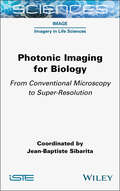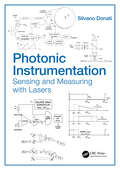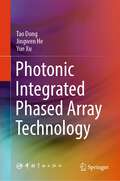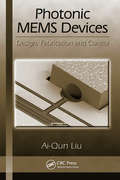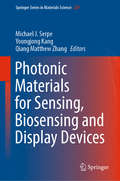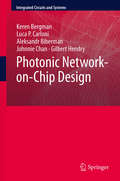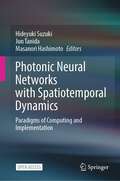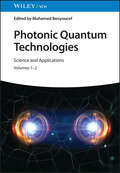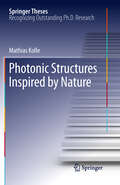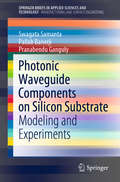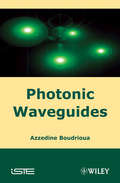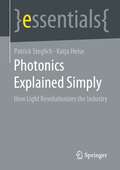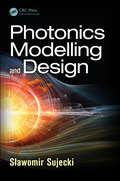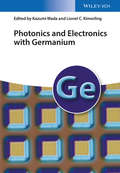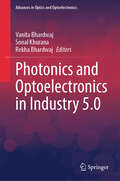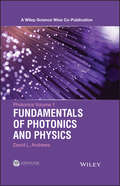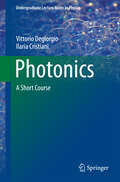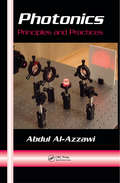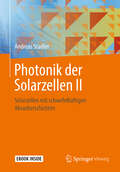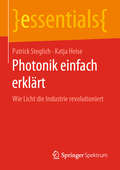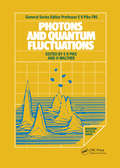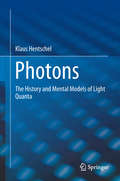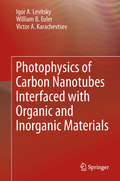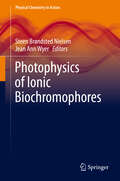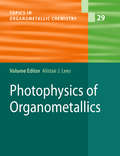- Table View
- List View
Photonic Imaging for Biology: From Conventional Microscopy to Super-Resolution (ISTE Invoiced)
by Jean-Baptiste SibaritaLight microscopy is a central tool in biological research, allowing scientists to observe living cells and organisms with details invisible to the naked eye. Since its inception in the 17th century, it has evolved through key innovations in optics, staining, electronics and informatics. Major milestones include phase contrast, differential interference contrast, immunofluorescence, genetically encoded fluorescent proteins, confocal microscopy and super-resolution microscopy. The discovery of Green Fluorescent Protein (GFP) revolutionized molecular biology, while 21st-century advances, such as super-resolution microscopy and artificial intelligence, have pushed imaging capabilities even further. Modern microscopes now integrate digital imaging, advanced optics and computational analysis for enhanced visualization and interpretation. Photonic Imaging for Biology outlines major microscopy techniques that have driven biological discoveries, starting with fundamental principles and covering a range of methods, including brightfield, fluorescence, confocal, light-sheet, single particle tracking, photoperturbation, fluorescence correlation spectroscopy and super-resolution microscopy. The book concludes with a chapter on image analysis, highlighting recent progress in artificial intelligence. Each chapter focuses on specific techniques and their applications, strengths and limitations.
Photonic Instrumentation: Sensing and Measuring with Lasers
by Silvano DonatiPhotonic Instrumentation: Sensing and Measuring with Lasers is designed as a source for university-level courses covering the essentials of laser-based instrumentation, and as a useful reference for working engineers. Photonic instruments have very desirable features like non-contact operation and unparalleled sensitivity. They have quickly become a big industrial success, passing unaffected through the bubble years and, not any less important, well-established methods in measurement science. This book offers coverage of the most proven instruments, with a balanced treatment of the optical and electronic aspects involved. It also attempts to present the basic principles, develop the guidelines of design and evaluate the ultimate limits of performances set by noise. The instruments surveyed include: alignment instruments, such as wire diameter and particle size analyzers, telemeters, laser interferometers and self-mixing interferometers, and speckle pattern instruments, laser doppler velocimeters, gyroscopes, optical fiber sensors and quantum sensing. A few appendices offer convenient reference material for key principles on lasers, optical interferometers, propagation, scattering and diffraction.
Photonic Integrated Phased Array Technology
by Yue Xu Tao Dong Jingwen HeThis book primarily focuses on the authors’ research and practical achievements in the field of photonic integrated phased arrays in recent years. Firstly, a comprehensive introduction on the concept, operation principles, and research progress of photonic integrated phased arrays is introduced. Then, detailed explanations of the optical antenna and array design in photonic integrated phased arrays are given. Combined with design cases of silicon-based optical phased arrays with different scales, the design methods for achieving low sidelobes are deeply researched, and the test principle and design of photonic integrated phased arrays are elaborated. Finally, the design, implementation, and test of photonic integrated phased arrays are illustrated through a detailed case study on the development of a silicon-based optical phased array chip and verify its short-distance space optical communication based on the chip.This book is dedicated to integrating the theory, design, processing, and test cases of photonic integrated phased arrays, and it provides a valuable reference for researchers and designers in the field of optical phased array technology.
Photonic MEMS Devices: Design, Fabrication and Control
by Ai-Qun LiuPhotonic MEMS devices represent the next major breakthrough in the silicon revolution. While many quality resources exist on the optic and photonic aspect of device physics, today’s researchers are in need of a reference that goes beyond to include all aspects of engineering innovation.An extension on traditional design and analysis, Photonic MEMS Devices: Design, Fabrication, and Control describes a broad range of optical and photonic devices, from MEMS optical switches and bandgap crystal switches to optical variable attenuators (VOA) and injection locked tunable lasers. It deals rigorously with all these technologies at a fundamental level, systematically introducing critical nomenclature. Each chapter also provides analysis techniques, equations, and experimental results. The book focuses not only on traditional design analysis, but also provides extensive background on realistic simulation and fabrication processes. With a clear attention to experimental relevance, this book provides the fundamental knowledge needed to take the next-step in integrating photonic MEMS devices into commercial products and technology.
Photonic Materials for Sensing, Biosensing and Display Devices (Springer Series in Materials Science #229)
by Michael J. Serpe Youngjong Kang Qiang Matthew ZhangThis book presents the basics and applications of photonic materials. It focuses on the utility of these devices for sensing, biosensing, and displays. The book includes fundamental aspects with a particular focus on the application of photonic materials. The field of photonic materials is both a burgeoning, and mature field. There are new advances being made on a daily basis, all based on the fundamental roots set by work by those like Ozin, Thomas, Asher, and others.
Photonic Network-on-Chip Design
by Keren Bergman Aleksandr Biberman Gilbert Hendry Luca P. Carloni Johnnie ChanThis book provides a comprehensive synthesis of the theory and practice of photonic devices for networks-on-chip. It outlines the issues in designing photonic network-on-chip architectures for future many-core high performance chip multiprocessors. The discussion is built from the bottom up: starting with the design and implementation of key photonic devices and building blocks, reviewing networking and network-on-chip theory and existing research, and finishing with describing various architectures, their characteristics, and the impact they will have on a computing system. After acquainting the reader with all the issues in the design space, the discussion concludes with design automation techniques, supplemented by provided software.
Photonic Neural Networks with Spatiotemporal Dynamics: Paradigms of Computing and Implementation
by Hideyuki Suzuki Jun Tanida Masanori HashimotoThis open access book presents an overview of recent advances in photonic neural networks with spatiotemporal dynamics. The computing and implementation paradigms presented in this book are outcomes of interdisciplinary studies by collaborative researchers from the three fields of nonlinear mathematical science, information photonics, and integrated systems engineering. This book offers novel multidisciplinary viewpoints on photonic neural networks, illustrating recent advances in three types of computing methodologies: fluorescence energy transfer computing, spatial-photonic spin system, and photonic reservoir computing. The book consists of four parts: Part I introduces the backgrounds of optical computing and neural network dynamics; Part II presents fluorescence energy transfer computing, a novel computing technology based on nanoscale networks of fluorescent particles; Parts III and IV review the models and implementation of spatial-photonic spin systems and photonic reservoir computing, respectively. These contents are beneficial to researchers in a broad range of fields, including information science, mathematical science, applied physics, and engineering, to better understand the novel computing concepts of photonic neural networks with spatiotemporal dynamics.
Photonic Quantum Technologies: Science and Applications
by Mohamed BenyoucefPhotonic Quantum Technologies Brings together top-level research results to enable the development of practical quantum devices In Photonic Quantum Technologies: Science and Applications, the editor Mohamed Benyoucef and a team of distinguished scientists from different disciplines deliver an authoritative, one-stop overview of up-to-date research on various quantum systems. This unique book reviews the state-of-the-art research in photonic quantum technologies and bridges the fundamentals of the field with applications to provide readers from academia and industry, in one-location resource, with cutting-edge knowledge they need to have to understand and develop practical quantum systems for application in e.g., secure quantum communication, quantum metrology, and quantum computing. The book also addresses fundamental and engineering challenges en route to workable quantum devices and ways to circumvent or overcome them. Readers will also find: A thorough introduction to the fundamentals of quantum technologies, including discussions of the second quantum revolution (by Nobel Laureate Alain Aspect), solid-state quantum optics, and non-classical light and quantum entanglement Comprehensive explorations of emerging quantum technologies and their practical applications, including quantum repeaters, satellite-based quantum communication, quantum networks, silicon quantum photonics, integrated quantum systems, and future vision Practical discussions of quantum technologies with artificial atoms, color centers, 2D materials, molecules, atoms, ions, and optical clocks Perfect for molecular and solid-state physicists, Photonic Quantum Technologies: Science and Applications will also benefit industrial and academic researchers in photonics and quantum optics, graduate students in the field; engineers, chemists, and computer and material scientists.
Photonic Structures Inspired by Nature
by Mathias KolleUnlike most natural colours that are based on pigment absorption, the striking iridescent and intense colouration of many butterflies, birds or beetles stems from the interaction of light with periodic sub-micrometer surface or volume patterns, so called "photonic structures". These "structural colours" are increasingly well understood, but they are difficult to create artificially and exploit technologically. In this thesis the field of natural structural colours and biomimetic photonic structures is covered in a wide scope, ranging from plant photonics to theoretical optics. It demonstrates diffractive elements on the petal surfaces of many flowering plant species; these form the basis for the study of the role of structural colours in pollinator attraction. Self-assembly techniques, combined with scale able nanofabrication methods, were used to create complex artificial photonic structures inspired by those found in nature. In particular, the colour effect of a Papilio butterfly was mimicked and, by variation of its design motive, enhanced. All photonic effects described here are underpinned by state-of-the-art model calculations.
Photonic Waveguide Components on Silicon Substrate: Modeling and Experiments (SpringerBriefs in Applied Sciences and Technology)
by Swagata Samanta Pallab Banerji Pranabendu GangulyThis book focuses on the design and development of SU-8 polymer and silicon waveguide-based devices using the effective index based matrix method. Various fabrication techniques like laser direct writing (LDW), Focused Ion Beam (FIB) and optical lithography are discussed. FIB lithography has been explored for photonic-crystal structures on the waveguide and for directional coupler in coupled region. This technique is shown to be suitable in fabricating photonic crystal structures as well as for making any precise modifications in micro- and nano-meter photonic waveguide structures. This book can be a useful reference for students, researchers, and fabrication engineers working in the areas of integrated optics, optical communications, laser technology and optical lithography for device manufacturing.
Photonic Waveguides: Theory and Applications (Wiley-iste Ser.)
by Azzedine BoudriouaThis book presents the principles of non-linear integrated optics. The first objective is to provide the reader with a thorough understanding of integrated optics so that they may be able to develop the theoretical and experimental tools to study and control the linear and non-linear optical properties of waveguides. The potential use of these structures can then be determined in order to realize integrated optical components for light modulation and generation. The theoretical models are accompanied by experimental tools and their setting in order to characterize the studied phenomenon. The passage from theory to practice makes the comprehension of the physical phenomena simple and didactic. The book also gives a presentation of the industrial applications of the integrated optical components. The studied topics range from the theory of waveguides and the linear and non-linear optical characterization techniques to photonic crystals. This last field constitutes a major challenge of photonic technologies of the 21st century.
Photonics Explained Simply: How Light Revolutionizes the Industry (essentials)
by Patrick Steglich Katja HeiseWe are at the crossroads of a new epoch: the age of electronics is being replaced by the age of photonics. This book will introduce you to the fascinating development of photonics, avoiding complicated technical terminology and instead explaining the physical fundamentals in a clear way. Based on this, important developments such as the laser and its applications in industry, research and everyday life are described. Complicated physical properties and technical details are explained to the reader in an understandable way.The authors:Dr. Patrick Steglich is lecturer for photonics and optical technologies at the Technical University of Applied Sciences Wildau and scientist at the Leibniz Institute for Innovative Microelectronics IHP in Frankfurt (Oder).Katja Heise works as an editor in Berlin. As a trained political scientist and journalist, she specializes in translating complex technical topics into simple language. The authors live together with their son and two daughters in Berlin.This Springer essential is a translation of the original German 1st edition essentials, Photonik einfach erklärt by Steglich Patrick and Katja Heise, published by Springer Fachmedien Wiesbaden GmbH, part of Springer Nature in 2019.The translation was done with the help of artificial intelligence (machine translation by the service DeepL.com). A subsequent human revision was done primarily in terms of content, so that the book will read stylistically differently from a conventional translation. Springer Nature works continuously to further the development of tools for the production of books and on the related technologies to support the authors.
Photonics Modelling and Design (Optical Sciences and Applications of Light)
by Slawomir SujeckiPhotonics Modeling and Design delivers a concise introduction to the modeling and design of photonic devices. Assuming a general knowledge of photonics and the operating principles of fibre and semiconductor lasers, this book: Describes the analysis of the light propagation in dielectric media Discusses heat diffusion and carrier transport Applies the presented theory to develop fibre and semiconductor laser models Addresses the propagation of short optical pulses in optical fibres Puts all modeling into practical context with examples of devices currently in development or on the market Providing hands-on guidance in the form of MATLAB® scripts, tips, and other downloadable content, Photonics Modeling and Design is written for students and professionals interested in modeling photonic devices either for gaining a deeper understanding of the operation or to optimize the design.
Photonics and Electronics with Germanium
by Lionel C. Kimerling Kazumi WadaRepresenting a further step towards enabling the convergence of computing and communication, this handbook and reference treats germanium electronics and optics on an equal footing. Renowned experts paint the big picture, combining both introductory material and the latest results. The first part of the book introduces readers to the fundamental properties of germanium, such as band offsets, impurities, defects and surface structures, which determine the performance of germanium-based devices in conjunction with conventional silicon technology. The second part covers methods of preparing and processing germanium structures, including chemical and physical vapor deposition, condensation approaches and chemical etching. The third and largest part gives a broad overview of the applications of integrated germanium technology: waveguides, photodetectors, modulators, ring resonators, transistors and, prominently, light-emitting devices. An invaluable one-stop resource for both researchers and developers.
Photonics and Optoelectronics in Industry 5.0 (Advances in Optics and Optoelectronics)
by Vanita Bhardwaj Sonal Khurana Rekha BhardwajThis book presents the role of photonic and optoelectronics with a focus on transformation of Industry 5.0. This book offers in-depth discussion of interfaces between human-machine collaboration. The introductory chapters discuss the fundamentals of photonics and optoelectronics as well as its use in real-time monitoring, additive manufacturing, and precision machining. Additionally, focus is placed on sustainability and energy efficiency, demonstrating how photonics may enhance industrial processes and assist renewable energy management. Finally, the book reviews the development of machine learning methods for optimization and the integration of artificial intelligence with photonic systems which are described in ample detail. In order to assist researchers those are not familiar with the subfield, each chapter starts by providing an overview of the primary concepts to be discussed.
Photonics, Volume 1: Fundamentals of Photonics and Physics (A Wiley-Science Wise Co-Publication)
by David L. AndrewsCovers modern photonics accessibly and discusses the basic physical principles underlying all the applications and technology of photonics.This volume covers the basic physical principles underlying the technology and all applications of photonics from statistical optics to quantum optics. The topics discussed in this volume are: Photons in perspective; Coherence and Statistical Optics; Complex Light and Singular Optics; Electrodynamics of Dielectric Media; Fast and slow Light; Holography; Multiphoton Processes; Optical Angular Momentum; Optical Forces, Trapping and Manipulation; Polarization States; Quantum Electrodynamics; Quantum Information and Computing; Quantum Optics; Resonance Energy Transfer; Surface Optics; Ultrafast Pulse Phenomena. Comprehensive and accessible coverage of the whole of modern photonics Emphasizes processes and applications that specifically exploit photon attributes of light Deals with the rapidly advancing area of modern optics Chapters are written by top scientists in their field Written for the graduate level student in physical sciences; Industrial and academic researchers in photonics, graduate students in the area; College lecturers, educators, policymakers, consultants, Scientific and technical libraries, government laboratories, NIH.
Photonics: A Short Course (Undergraduate Lecture Notes in Physics)
by Vittorio Degiorgio Ilaria CristianiThis book will serve as a concise, self-contained, up-to-date introduction to Photonics, to be used as a textbook for undergraduate students or as a reference book for researchers and professionals. Blending theory with technical descriptions, the book covers a wide range of topics, including the general mechanism of laser action, continuous and pulsed laser operation, optical propagation in isotropic and anisotropic media, operating principles and structure of passive optical components, electro-optical and acousto-optical modulation, solid-state lasers, semiconductor lasers and LEDs, nonlinear optics, and optical fiber components and devices. The book concludes with an overview of applications, including optical communications, telemetry and sensing, industrial and biomedical applications, solid-state lighting, displays and photovoltaics.
Photonics: Principles and Practices (Optical Science and Engineering #123)
by Abdul Al-Azzawi<p>Since the invention of the laser, our fascination with the photon has led to one of the most dynamic and rapidly growing fields of technology. An explosion of new materials, devices, and applications makes it more important than ever to stay current with the latest advances. Surveying the field from fundamental concepts to state-of-the-art developments, Photonics: Principles and Practices builds a comprehensive understanding of the theoretical and practical aspects of photonics from the basics of light waves to fiber optics and lasers. Providing self-contained coverage and using a consistent approach, the author leads you step-by-step through each topic. <p>Each skillfully crafted chapter first explores the theoretical concepts of each topic and then demonstrates how these principles apply to real-world applications by guiding you through experimental cases illuminated with numerous illustrations. Coverage is divided into six broad sections, systematically working through light, optics, waves and diffraction, optical fibers, fiber optics testing, and laboratory safety. A complete glossary, useful appendices, and a thorough list of references round out the presentation. <p>The text also includes a 16-page insert containing 28 full-color illustrations. Containing several topics presented for the first time in book form, Photonics: Principles and Practices is simply the most modern, comprehensive, and hands-on text in the field.</p>
Photonik der Solarzellen II: Solarzellen Mit Schwefelhaltigen Absorberschichten
by Andreas StadlerSpezielle potentielle Absorber-Material-Konzepte werden vorgestellt. und diskutiert. Experimentell ermittelte Parameter son Solarzellen mit schwefelhaltigen Absorberschichten sind besprochen sowie unterschiedlichen Puffer- und Zwischenschichten (z. B. CdS, i-ZnO:Al, Bi2S3) und deren Einfluss auf die Funktion von Solarzellen. Konzentrations-Variationen unterschiedlicher Elemente (z.B. Sn, Pb, Bi, Sb, Cu, S) und typischen Sputter-Parametern auf die physikalischen Werte der untersuchten Dünnschichten können nachvollzogen werden.
Photonik einfach erklärt: Wie Licht die Industrie revolutioniert (essentials)
by Patrick Steglich Katja HeiseWir befinden uns am Scheideweg einer neuen Epoche: Das Zeitalter der Elektronik wird abgelöst vom Zeitalter der Photonik. Dieses Buch führt Sie in die faszinierende Entwicklung der Photonik ein und verzichtet dabei auf komplizierte Fachsprache, vielmehr werden die physikalischen Grundlagen anschaulich erklärt. Darauf aufbauend werden wichtige Entwicklungen wie zum Beispiel der Laser und dessen Anwendungen in der Industrie, Forschung und im Alltag beschrieben. Komplizierte physikalische Eigenschaften und technische Details werden dem Leser in verständlicher Art und Weise erklärt.Die Autoren:Dr. Patrick Steglich ist Dozent für Photonik und optische Technologien an der Technischen Hochschule Wildau und Wissenschaftler am Leibniz-Institut für innovative Mikroelektronik IHP in Frankfurt (Oder). Katja Heise arbeitet als Redakteurin in Berlin. Als gelernte Politologin und Journalistin hat sie sich darauf spezialisiert, komplexe Fachthemen in einfache Sprache zu übersetzen. Die Autoren leben gemeinsam mit ihrem Sohn und ihren zwei Töchtern in Berlin.
Photons and Quantum Fluctuations
by E R Pike; H Walther I Abram M Le Berre C Fabre E Giacobino F Haake A Heidmann C K Hong R Horowicz R Loudon L Mandel G L Mander Z Y Ou E R Pike J G Rarity S Reynaud Sarben Sarkar T J Shepherd P R Tapster H Walther M Wilkens H P YuenBased on a special ONR seminar, Photons and Quantum Fluctuations draws together discoveries in nonclassical or "silent" light for research workers and postgraduates in quantum optics. With nonclassical light, noise is reduced in amplitude below that expected by previous applications of the uncertainty principles. Historians of science who wish to ponder the philosophical implications of these developments may also find this a useful volume.
Photons: The History and Mental Models of Light Quanta
by Klaus Hentschel Ann M. HentschelThis book focuses on the gradual formation of the concept of ‘light quanta’ or ‘photons’, as they have usually been called in English since 1926. The great number of synonyms that have been used by physicists to denote this concept indicates that there are many different mental models of what ‘light quanta’ are: simply finite, ‘quantized packages of energy’ or ‘bullets of light’? ‘Atoms of light’ or ‘molecules of light’? ‘Light corpuscles’ or ‘quantized waves’? Singularities of the field or spatially extended structures able to interfere? ‘Photons’ in G.N. Lewis’s sense, or as defined by QED, i.e. virtual exchange particles transmitting the electromagnetic force?The term ‘light quantum’ made its first appearance in Albert Einstein’s 1905 paper on a “heuristic point of view” to cope with the photoelectric effect and other forms of interaction of light and matter, but the mental model associated with it has a rich history both before and after 1905. Some of its semantic layers go as far back as Newton and Kepler, some are only fully expressed several decades later, while others initially increased in importance then diminished and finally vanished. In conjunction with these various terms, several mental models of light quanta were developed—six of them are explored more closely in this book. It discusses two historiographic approaches to the problem of concept formation: (a) the author’s own model of conceptual development as a series of semantic accretions and (b) Mark Turner’s model of ‘conceptual blending’. Both of these models are shown to be useful and should be explored further.This is the first historiographically sophisticated history of the fully fledged concept and all of its twelve semantic layers. It systematically combines the history of science with the history of terms and a philosophically inspired history of ideas in conjunction with insights from cognitive science.
Photophysics of Carbon Nanotubes Interfaced with Organic and Inorganic Materials
by Victor A. Karachevtsev William B. Euler Igor A. LevitskyPhotophysics of Carbon Nanotubes Interfaced with Organic and Inorganic Materials describes physical, optical and spectroscopic properties of the emerging class of nanocomposites formed from carbon nanotubes (CNTs) interfacing with organic and inorganic materials. The three main chapters detail novel trends in photophysics related to the interaction of light with various carbon nanotube composites from relatively simple CNT/small molecule assemblies to complex hybrids such as CNT/Si and CNT/DNA nanostructures. The latest experimental results are followed up with detailed discussions and scientific and technological perspectives to provide a through coverage of major topics including: -Light harvesting, energy conversion, photoinduced charge separation and transport in CNT based nanohybrids -CNT/polymer composites exhibiting photoactuation; and -Optical spectroscopy and structure of CNT/DNA complexes. Including original data and a short review of recent research, Photophysics of Carbon Nanotubes Interfaced with Organic and Inorganic Materials makes this emerging field of photophysics and its applications available to academics and professionals working with carbon nanotube composites in fundamental and applied fields
Photophysics of Ionic Biochromophores
by Steen Brøndsted Nielsen Jean Ann WyerThis book provides a concise overview of the photophysics and spectroscopy of bio chromophore ions. The book "Photophysics of Ionic Biochromophores" summarizes important recent advances in the spectroscopy of isolated biomolecular ions in vacuo, which has within the last decade become a highly active research field. Advanced instrumental apparatus and the steady increase in more and more powerful computers have made this development possible, both for experimentalists and theoreticians. Applied techniques described here include absorption and fluorescence spectroscopy, which are excellent indicators of environmental effects and can thus shed light on the intrinsic electronic structures of ions without perturbations from e. g. water molecules, counter ions, nearby charges, and polar amino acid residues. When compared with spectra of the chromophores in their natural environment, such spectra allow to identify possible perturbations. At the same time gas-phase spectra provide important benchmarks for quantum chemistry calculations of electronically excited states. This volume focuses on biological systems from protein biochromophores, e. g. the protonated Schiff-base retinal responsible for vision, and individual aromatic amino acids to peptides and whole proteins, studied using visible, ultraviolet and vacuum ultraviolet light. Work on DNA nucleotides and strands that are amenable to mass spectrometric studies because of the negatively charged sugarphosphate backbone are also presented. DNA strands represent an example of the interplay between multiple chromophores, which is even harder to model correctly than just single chromophores due to spatially extended excited states and weak coupling terms. The experimental techniques used to measure spectra and commonly used theoretical methods are described with a discussion on limitations and advantages. The volume includes an updated status of the field and interesting future directions such as cold ion spectroscopy.
Photophysics of Organometallics
by Alistair J. LeesArvind Kumar, Shih-Sheng Sun, and Alistair J. Lees: Photophysics and Photochemistry of Organometallic Rhenium Diimine Complexes; Conor Long: Photophysics of CO Loss from Simple Metal Carbonyl Complexes; Antonín Vlcek Jr: Ultrafast Excited-State Processes in Re(I) Carbonyl-Diimine Complexes: From Excitation to Photochemistry; Kenneth Kam-Wing Lo: Exploitation of Luminescent Organometallic Rhenium(I) and Iridium(III) Complexes in Biological Studies; Maria L. Muro , Aaron A. Rachford , Xianghuai Wang, and Felix N. Castellano: Platinum II Acetylide Photophysics; Andreas F. Rausch, Herbert H. H. Homeier, and Hartmut Yersin: Organometallic Pt(II) and Ir(III) Triplet Emitters for OLED Applications and the Role of Spin-Orbit Coupling: A Study Based on High-Resolution Optical Spectroscopy.
